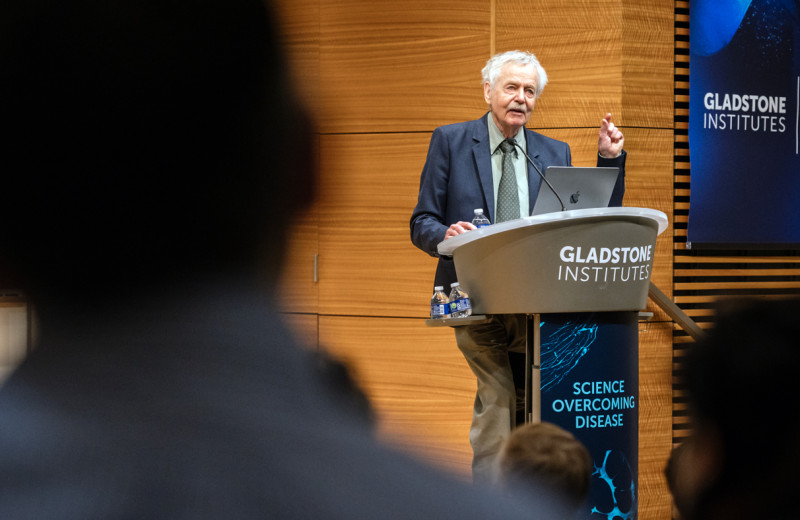Gladstone NOW: The Campaign Join Us on the Journey✕

Gladstone is hosting its second annual Research Associate Appreciation Week to celebrate the contributions of our RAs.
Research associates (RAs) are an important part of Gladstone’s scientific community. Some RAs use the position as a starting point to gain experience before they return to school for an MD or PhD, while for others, the research associate position is a lifelong scientific role and a way to make meaningful contributions to science.
Last year, Gladstone’s community group, Gladstone Research Associate Committee (GRAC), launched the first RA Appreciation Week. In honor of our second annual RA Appreciation Week celebration, we asked our RAs to explain their role and what drew them to the science they’re working on.
Sarah Rockwood, McDevitt Lab
What is the role of a research associate in a science lab?
A research associate means different things in different institutions, and when I started at Gladstone, I thought I’d be seen as a kind of tech. I was elated to discover how wrong I was. I was fully welcomed into the team as a capable and independent scientist who wasn’t put in any special hierarchical place. While I’m not a trainee, I collaboratively work with trainees at all stages in their career as well as other RAs to contribute to multiple projects in parallel, both in supportive and sometimes leading roles, which is an incredible opportunity I’ve been grateful to experience at Gladstone.
What are your goals for your scientific career?
I hope to build on my foundation at Gladstone to continue growing as a stem cell scientist and one day help patients through medical care and translational research as a physician scientist. My next step toward the goal will be joining the Medical Scientist Training Program (MD-PhD) at Stanford University this fall. I would never have reached this point without the incredible mentorship and support of the McDevitt Lab and the greater Gladstone community!
Do you have advice for people who are interested in a career in science?
My advice is to get involved early in research you are curious about, and find people and an environment you are excited to come to work with every day. You don't have to have a passion for the subject from day one. Passion isn’t just found, but developed over time and dedication. Follow your intuition and those sparks of excitement when pursuing opportunities. And try to identify mentors who will both support and push you wherever you can—they will be more than invaluable in your journey.
Arjun Kumar, Weinberger Lab
What drew you to the science you’re currently working on?
In the lab of Leor Weinberger, I work on Therapeutic Interfering Particles (TIPs), a novel antiviral approach with the potential to treat HIV with a single dose or treat SARS-CoV-2 regardless of spike protein variants. I was drawn to this science because it brought bold, creative thinking to really difficult problems—the work seemed high-risk, high-reward, which was exactly the kind of science I wanted to pursue. I’m interested in engineering viruses that can treat and cure disease, and TIPs are a prime example of that.
Have you had a particularly inspiring mentor or role model? What did you learn from them?
In addition to my incredibly creative and insightful investigator, Leor, I’ve been so fortunate to learn from two amazing mentors in the lab—postdocs Elizabeth Tanner and Sonali Chaturvedi. I’ve worked with Elizabeth and Sonali on HIV/SIV and SARS-CoV-2 respectively, and having two different mentors has been so enlightening. Both bring such deep experience and expertise but think about science in different ways, really informing how I’ll approach science in graduate school.
Marty Krakora, McDevitt Lab
What are your goals for your scientific career?
Ultimately, I’d love to be able to write software to analyze and model diseases. I think that computer models can be leveraged to more completely connect patient data with genomic data and understand genetic heritability in diseases. I’d love to then use those findings to construct experimental models to test information gleaned from the computers. I believe that combining these techniques could establish direct relationships in many biological phenomena—including many diseases and aspects of development.
Have you had a particularly inspiring mentor or role model? What did you learn from them?
I was lucky to have a couple of awesome bioinformatics mentors throughout my undergrad and postgrad training who first introduced me to the field, taught me a lot of technical skills, and were always around to answer my questions. They showed me how to ask insightful questions and they always supported my career goals even though I don’t come from a traditional informatics background.
What drew you to the science you’re currently working on?
I was drawn to bioinformatics a few years ago and I loved the feeling of trusting computers, watching billions of calculations carried out within less than a second, and having answers that pertained to relevant biological questions. Then as part of Todd McDevitt’s lab, I’ve also gotten to do a lot of cool stem cell engineering and image analysis. This is my favorite combination of science—super cool biology alongside computational tools. Currently, I’m working with Ivana Vasic, a graduate student in the lab, and helping with both lab experiments and data analysis in her project investigating epithelial structure in pluripotency state and germ lineage potential.
Gladstone Scientists Show Appreciation to Their RAs
A few Gladstone scientists recorded statements to say thanks to the RAs working in their labs.
Want to Join the Team?
Our people are our most important asset. We offer a wide array of career opportunities both in our administrative offices and in our labs.
Explore CareersA Sculptor of Modern Regenerative Medicine
A Sculptor of Modern Regenerative Medicine
Among his myriad accomplishments, Rudolf Jaenisch—winner of the 2025 Ogawa-Yamanaka Stem Cell Prize—was the first to demonstrate the potential of induced pluripotent stem cells to treat disease.
Awards Ogawa Stem Cell Prize Profile Regenerative Medicine Stem Cells/iPSCsMeet Gladstone: Shijie Wang
Meet Gladstone: Shijie Wang
Shijie Wang, a postdoctoral scholar in Steve Finkbeiner’s lab, uses artificial intelligence, robotics, and stem cell technologies to uncover how brain cells die in neurodegenerative diseases like Alzheimer’s and Parkinson’s.
Profile Neurological Disease Finkbeiner Lab AI Robotic MicroscopyMeet Gladstone: Oscar Yip
Meet Gladstone: Oscar Yip
Oscar Yip is advancing Alzheimer’s research in Yadong Huang’s lab at Gladstone while drawing inspiration from his family, community, and his broader goal of helping patients.
Graduate Students and Postdocs Profile Alzheimer’s Disease



